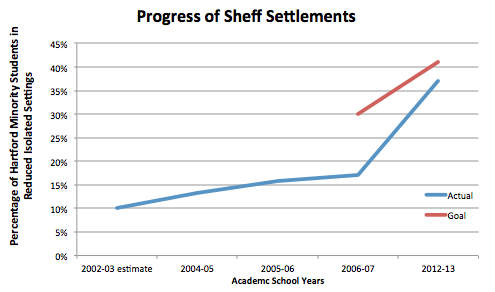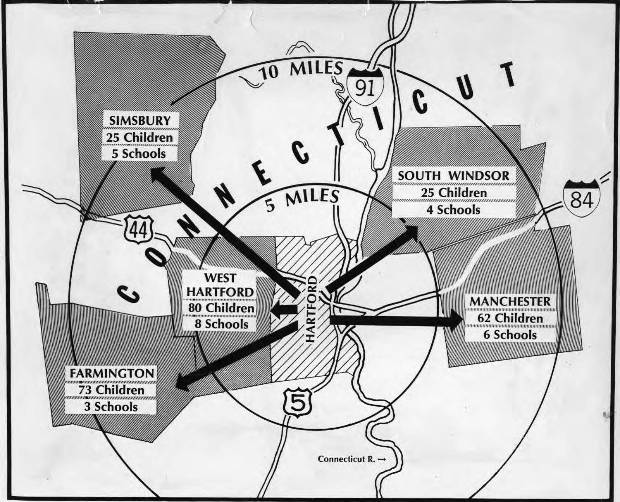by Brigit Rioual
In 1989, Milo Sheff, then a fourth grader, and 17 other children filed a lawsuit through their parents. The plaintiffs called attention to the inequalities between Hartford’s schools, which largely served minorities, and suburban schools, which had predominantly white student populations. The lawsuit’s goal was to provide an integrated, equal educational opportunity to both urban and suburban students. After years of deliberation, a decision was made in 1996 when the Connecticut Supreme Court ruled 4-3, in favor of Sheff. The court stated that the separation of suburban and Hartford students violated the segregation clause in the Connecticut Constitution and it ruled that the state was obligated to provide equal educational opportunity for all students. With that, the court urged the State to find ways to promote desegregation but did not set any specific goals or timetables.
2003 Settlement Proposes Action Plan and Benchmarks
After the ruling in 1996, the Sheff plaintiffs were dissatisfied; they saw little in the way of substantive change or planning. As a result, they filed a proposal in 2000 and in 2003 the parties reached a legal settlement. The settlement included specific plans to be implemented according to a four-year timetable, and it called for at least 30% of Hartford minority students to be in reduced-isolation settings. These were defined as schools where minorities constituted less than 75% of the student body.
The settlement proposed three means of reducing economic, racial, and ethnic isolation for students: interdistrict cooperative programs, interdistrict magnet schools, and the Open Choice program, also known as Project Choice. The goal for Open Choice, a voluntary two-way transfer program designed to enable Hartford students to attend suburban schools and suburban students to attend schools in the capital city, was to have 1,600 students enrolled by 2007. Another outcome stipulated by the settlement was that additional magnet schools, with special themes to attract suburban and city students, would be created in the Hartford region.
Five years later, program evaluations showed that Open Choice has met with mixed results. Although the interdistrict magnet schools were intended to attract a diverse body of students, enrollment data showed that the racial composition of their student populations varied immensely. While some met the criteria of at least 25% but no more than 75% minority students, others had too few or too many minorities. Additionally, many of the minority students attending these magnet schools were not even Hartford residents; they were instead residents of the surrounding suburban towns. Even though there was an increase in magnet schools during this time, the main goals of the settlement were not met. Only 17% of Hartford minority students were in reduced-isolation settings and only 1,070 students were enrolled in Open Choice.

Actual and Legal Process toward Sheff I & Sheff II Goal, 2003-2013 – Data Source: Dougherty et al. “Sheff v O’Neill: Weak Desegregation Remedies,” Figure 5.1, p. 111; Thomas. “State Falls Short on School Desegregation Requirements – The Connecticut Mirror.”
Falling Short of Goals, Parties Reach New Settlement
Since the goals of the 2003 settlement were not met, the parties negotiated a second settlement in 2008. This time, measures of success focused on increasing the number of Hartford-resident minority students attending reduced-isolation schools. With that, two goals were created: 1) that at least 80% of Hartford minority students wishing to attend reduced-isolation schools would be accommodated and 2) that at least 41% of minority students from Hartford would be enrolled in a reduced-isolation school. In addition to this, the settlement included a descriptive plan for magnet, Project Choice, and other participating schools to follow.
The date for reaching these settlement goals was the 2012-2013 academic school year. By this time, 72% of Hartford minority students who applied to reduced-isolation schools had been accepted. This fell short of the targeted 80%. Also, only 37% of Hartford minority students were enrolled in a reduced-isolation school. Although this represented an increase since 2003, the 2008 settlement goal of 41% was not achieved. Because the programs did not meet these critical benchmarks, state officials and the Sheff plaintiffs will meet to negotiate a new settlement—and the effort to address the educational imbalances brought about by ethnic, racial, and economic segregation will continue.
Brigit Rioual, a junior at Trinity College in Hartford during the 2012-13 academic year, is a double major in Educational Studies and Sociology.









